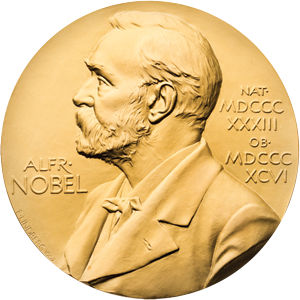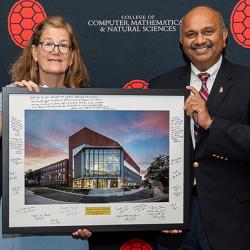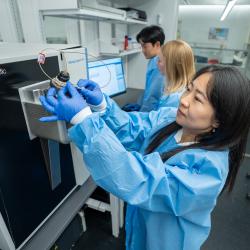Our Fearless Ideas Made Us Nobel Laureates
John Mather
Nobel Prize in Physics, 2006
According to the Big Bang theory, cosmic microwave background radiation—an electromagnetic "glow" filling the universe—should have certain properties. In 1974, John Mather led a team at NASA's Goddard Space Flight Center that analyzed this radiation. Their experimental results matched theoretical predictions, confirming the Big Bang theory. Mather, who joined UMD as a College Park Professor of Physics in 1992, shared the Nobel Prize for the "discovery of the blackbody form and anisotropy of the cosmic microwave background radiation."
"I came to the University of Maryland because it's a great place to do science and it cooperates very well with NASA Goddard," said Mather, who continues to hold positions at NASA and UMD. "I have opportunities to collaborate with university professors on potential future space missions and new technology for ground-based observatories." Mather earned a B.S. in physics from Swarthmore College in Pennsylvania and a Ph.D. in physics from the University of California, Berkeley.
Raymond Davis Jr. (1914–2006)
Nobel Prize in Physics, 2002
Raymond Davis Jr., B.S. '37, M.S. '40, industrial chemistry, joined Brookhaven National Laboratory in 1948. There, he led a team that determined that the sun emits neutrinos—particles formed during the nuclear fusion reactions that produce the sun's energy. Davis and his team built a 100,000-gallon tank 4,850 feet underground in the Homestake Mine in South Dakota to detect neutrinos. Starting in 1968, the Homestake Experiment began yielding results that eventually demonstrated the existence of solar neutrinos and confirmed that nuclear fusion occurs in the sun. Davis shared the Nobel Prize "for pioneering contributions to astrophysics, in particular for the detection of cosmic neutrinos."
The study of neutrinos continues to reveal new information about our universe. In 2018, UMD physicists helped find the first evidence that high-energy cosmic neutrinos and cosmic rays may come from supermassive black holes.
Davis earned a Ph.D. in physical chemistry from Yale University.
William Phillips
Nobel Prize in Physics, 1997
William Phillips joined what is now the National Institute of Standards and Technology (NIST) in 1978 to research laser cooling, which slows atoms for applications such as atomic clocks. There, he developed the Zeeman slower, an apparatus that captures and slows atoms. Phillips shared the Nobel Prize for the "development of methods to cool and trap atoms with laser light."
Phillips joined UMD in 1992 and was named a Distinguished University Professor and College Park Professor of Physics in 2001 and 2006, respectively. Phillips also helped launch the Joint Quantum Institute (JQI), a research partnership between the university and NIST that is headquartered on UMD's College Park campus.
"Today, the activity at the JQI exceeds my fondest dreams," said Phillips, who is also a JQI fellow. "JQI brings theorists and experimenters from the University of Maryland and NIST together with students and postdocs from all over the world in one of the most creative environments ever assembled for exploring the quantum mysteries of the universe."
Phillips earned a B.S. in physics from Juniata College in Pennsylvania and a Ph.D. in physics from the Massachusetts Institute of Technology.
Herbert Hauptman (1917-2011)
Nobel Prize in Chemistry, 1985
In 1947, Herbert Hauptman, Ph.D. '55, mathematics, began a collaboration with Naval Research Laboratory scientist Jerome Karle on X-ray crystallography, a technique used to determine the structure of molecules.
At the time, X-ray crystallography could only determine certain simple molecular structures. Hauptman and Karle developed equations that made it possible to directly determine the structure of larger molecules, such as proteins, using X-rays. This work enabled biological research and medical advances. Hauptman and Karle shared the Nobel Prize for "outstanding achievements in the development of direct methods for the determination of crystal structures."
Hauptman joined the Medical Foundation of Buffalo in 1970 and later became the organization's president. In 1994, the foundation was renamed the Hauptman-Woodward Medical Research Institute in honor of Hauptman as well as Helen Woodward Rivas, who helped establish the foundation.
Hauptman earned a B.S. in mathematics from the City College of New York and an M.A. in mathematics from Columbia University.
Written by Z. Irene Ying
See also:
Fearless Science: A Half-Century of Bold Research: Ten stories—one from each of our departments—highlight some of the most exciting scientific discoveries made by faculty members in the college during the last half-century.
This article was published in the Winter 2019 issue of Odyssey magazine. To read other stories from that issue, please visit go.umd.edu/odyssey.








